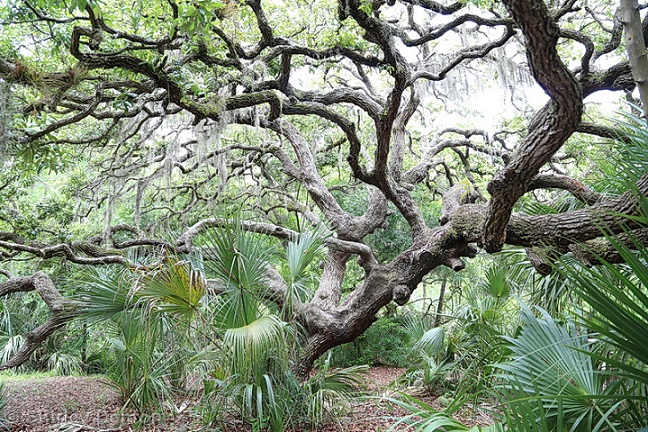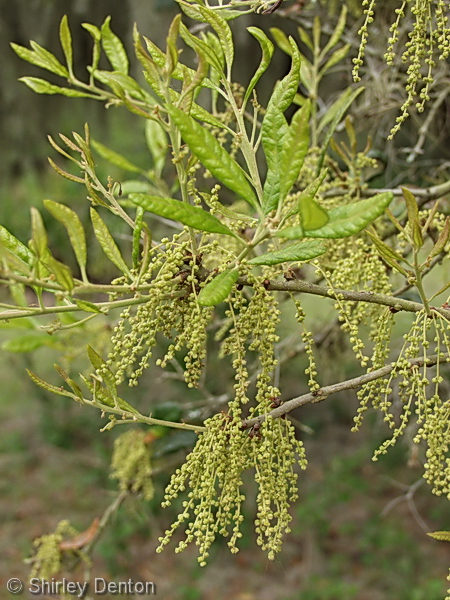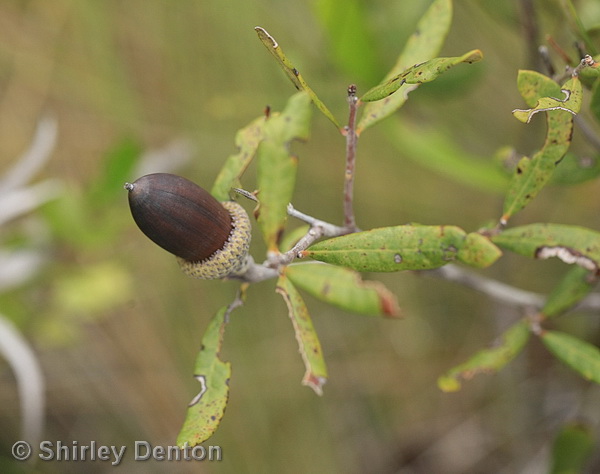Difference between revisions of "Quercus geminata"
Juliec4335 (talk | contribs) |
HaleighJoM (talk | contribs) (→Ecology) |
||
| (4 intermediate revisions by 3 users not shown) | |||
| Line 33: | Line 33: | ||
==Ecology== | ==Ecology== | ||
===Habitat=== <!--Natural communities, human disturbed habitats, topography, hydrology, soils, light, fire regime requirements for removal of competition, etc.--> | ===Habitat=== <!--Natural communities, human disturbed habitats, topography, hydrology, soils, light, fire regime requirements for removal of competition, etc.--> | ||
| − | In the Coastal Plain in Florida and Georgia, ''Q. geminata'' has occurred around karst ponds, sand pine scrubs, sand pine-oak scrubs, mixed pine-hardwood forests, live oak woodlands, beach ridges, sand dunes, high river banks, coastal hammocks, an oak hammock adjacent to a marsh, longleaf pine sand ridges, scrub oak dunes,a pine-palmetto hammock in a salt marsh, and open wiregrass-longleaf flatwoods. It has been found in disturbed areas such as planted slash pine stands, shallow disturbed ravines, open pastures, sandy roadsides, and deep sandy soil of a once cultivated field. Soil types include sandy loam, sand and loamy sand. | + | In the Coastal Plain in Florida and Georgia, ''Q. geminata'' has occurred around karst ponds, sand pine scrubs, sand pine-oak scrubs, mixed pine-hardwood forests, live oak woodlands, beach ridges, sand dunes, high river banks, coastal hammocks, an oak hammock adjacent to a marsh, longleaf pine sand ridges, scrub oak dunes,a pine-palmetto hammock in a salt marsh, and open wiregrass-longleaf flatwoods. It has been found in disturbed areas such as planted slash pine stands, shallow disturbed ravines, open pastures, sandy roadsides, and deep sandy soil of a once cultivated field. Soil types include sandy loam, sand and loamy sand.<ref name="fsu"/> |
| − | ''Quercus | + | Associated species include ''Pinus palustris, Quercus laevis, Q. incana, Q. virginiana, Q. hemisphaerica, Vaccinium stamineum, V. arboreum, Serenoa repens, Cyrilla racemiflora, Prunus serotina, Prunus umbellata, Diospyros virginiana, Rhus copallina, Rubus cuneifolius, Licania michauxii'', and ''Warea sessilifolia.''<ref name="fsu">Florida State University Robert K. Godfrey Herbarium database. URL: http://herbarium.bio.fsu.edu. Last accessed: November 2015. Collectors: Loran C. Anderson, Wilson Baker, Tom Barnes, Celeste Baylor, Michael Brooks, M.R. Darst, J.P. Davis, D.L. Fichtner, Richard Franz, Angus Gholson, Robert K. Godfrey, D.W. Hall, Bruce Hansen, JoAnn Hansen, Walter S. Judd, Paul Kalaz, Robert Kral, O. Lakela, Sidney McDaniel, C.W. O’Brien, N.A. Reasoner, Ann M. Redmond, W.D. Reese, Cecil R. Slaughter, Cindi Stewart. States and Counties: Florida: Bay, Dixie, Duval, Calhoun, Citrus, Clay, Dixie, Escambia, Flagler, Franklin, Gulf, Hillsborough, Jackson, Leon, Liberty, Manatee, Marion, Okaloosa, Osceola, Pinellas, Polk, Putnam, St. Johns, St. Lucie, Sumter, Wakulla. Georgia: Baker, Brooks. Compiled by Tall Timbers Research Station and Land Conservancy.</ref> |
''Quercus geminata'' is frequent and abundant in the Peninsula Xeric Sandhills, North Florida Longleaf Woodlands, Xeric Flatwoods, and Central Florida Flatwoods/Prairies community types as described in Carr et al. (2010).<ref>Carr, S.C., K.M. Robertson, and R.K. Peet. 2010. A vegetation classification of fire-dependent pinelands of Florida. Castanea 75:153-189.</ref> | ''Quercus geminata'' is frequent and abundant in the Peninsula Xeric Sandhills, North Florida Longleaf Woodlands, Xeric Flatwoods, and Central Florida Flatwoods/Prairies community types as described in Carr et al. (2010).<ref>Carr, S.C., K.M. Robertson, and R.K. Peet. 2010. A vegetation classification of fire-dependent pinelands of Florida. Castanea 75:153-189.</ref> | ||
| Line 43: | Line 43: | ||
===Seed dispersal=== | ===Seed dispersal=== | ||
| − | This species is thought to be dispersed by gravity. <ref>Kirkman, L. Katherine. Unpublished database of seed dispersal mode of plants found in Coastal Plain longleaf pine-grasslands of the Jones Ecological Research Center, Georgia.</ref> | + | This species is thought to be dispersed by gravity.<ref>Kirkman, L. Katherine. Unpublished database of seed dispersal mode of plants found in Coastal Plain longleaf pine-grasslands of the Jones Ecological Research Center, Georgia.</ref> |
<!--===Seed bank and germination===--> | <!--===Seed bank and germination===--> | ||
| Line 49: | Line 49: | ||
It can resprout after being top-killed by fire, 80% of the biomass is speculated to be underground.<ref name="floridata"/> Fire increases the density of grasshoppers found on ''Q. geminata.''<ref name="kerstyn">Kerstyn, A. and P. Stiling (1999). "The Effects of Burn Frequency on the Density of Some Grasshoppers and Leaf Miners in a Florida Sandhill Community." The Florida Entomologist 82(4): 499-505</ref> Fire does not affect the amount of ''Stilbosis quadricustatella'' miners on ''Q. geminata'' leaves.<ref name="mopper">[[Mopper, S., M. Beck, et al. (1995). "Local Adaptation and Agents of Selection in a Mobile Insect." Evolution 49(5): 810-815</ref> | It can resprout after being top-killed by fire, 80% of the biomass is speculated to be underground.<ref name="floridata"/> Fire increases the density of grasshoppers found on ''Q. geminata.''<ref name="kerstyn">Kerstyn, A. and P. Stiling (1999). "The Effects of Burn Frequency on the Density of Some Grasshoppers and Leaf Miners in a Florida Sandhill Community." The Florida Entomologist 82(4): 499-505</ref> Fire does not affect the amount of ''Stilbosis quadricustatella'' miners on ''Q. geminata'' leaves.<ref name="mopper">[[Mopper, S., M. Beck, et al. (1995). "Local Adaptation and Agents of Selection in a Mobile Insect." Evolution 49(5): 810-815</ref> | ||
| − | ===Pollination=== | + | <!--===Pollination===--> |
| − | + | ===Herbivory and toxicology===<!--Common herbivores, granivory, insect hosting, poisonous chemicals, allelopathy, etc--> | |
| + | ''Quercus geminata'' has been observed to host leafhoppers such as ''Eratoneura parva'' (family Cicadellidae).<ref>Discoverlife.org [https://www.discoverlife.org/20/q?search=Bidens+albaDiscoverlife.org|Discoverlife.org]</ref> Various Hymenoptera species were observed visiting flowers of ''Q. geminata'' at the Archbold Biological Station. These include ground-nesting wasps such as ''Andrena dimorpha'' (family Andrenidae), bees such as ''Apis mellifera'' (family Apidae), plasterer bees such as ''Colletes brimleyi'' (family Colletidae), and sweat bees such as ''Augochlora pura'' (family Halictidae).<ref>Deyrup, M.A. 2015. Database of observations of Hymenoptera visitations to flowering plants on Archbold Biological Station, Florida, USA.</ref> | ||
| − | + | The acorns of ''Q. geminata'' provide food for wildlife such as quail, jays, wood duck, sapsuckers, and wild turkeys.<ref name="usanpn">[[https://www.usanpn.org/nn/Quercus_geminata]]Accessed: March 7, 2016</ref> This species is also a promary larval host plant for oak hairstreak (''Fixsenia favonius''), horace's duskywing (''Erynnis haratius''), red-banded hairstreak (''Calycopis cecrops'') and white M hairstreak (''Parrhasius m-album'') butterflies.<ref name="regional">[[http://regionalconservation.org/beta/nfyn/plantdetail.asp?tx=Quergemi]]Accessed: March 7, 2016</ref> | |
| + | <!--===Diseases and parasites===--> | ||
| − | + | ==Conservation, cultivation, and restoration== | |
| − | |||
| − | |||
| − | |||
| − | |||
| − | |||
| − | == | ||
| − | |||
| − | |||
| − | == | + | ==Cultural use== |
| − | |||
==Photo Gallery== | ==Photo Gallery== | ||
<gallery widths=180px> | <gallery widths=180px> | ||
Latest revision as of 14:41, 15 July 2022
| Quercus geminata | |
|---|---|

| |
| Photo by Shirley Denton (Copyrighted, use by photographer’s permission only), Nature Photography by Shirley Denton | |
| Scientific classification | |
| Kingdom: | Plantae |
| Division: | Magnoliophyta - Flowering plants |
| Class: | Magnoliopsida – Dicotyledons |
| Order: | Fagales |
| Family: | Fagaceae |
| Genus: | Quercus |
| Species: | Q. geminata |
| Binomial name | |
| Quercus geminata Small | |

| |
| Natural range of Quercus geminata from USDA NRCS Plants Database. | |
Common name: Sand live oak
Contents
Taxonomic notes
Synonym: Quercus virginiana RAB
Quercus is formed from two Celtic words: quer (beautiful) cuez (tree). Geminata is Latin for twin, this refers to the acorns growing in pairs.[1]
Description
A description of Quercus geminata is provided in The Flora of North America.
Distribution
Q. geminata occurs in the lower Coastal Plain from southeastern Virginia to south-central Florida, along the Gulf to southern Mississippi.[1]
Ecology
Habitat
In the Coastal Plain in Florida and Georgia, Q. geminata has occurred around karst ponds, sand pine scrubs, sand pine-oak scrubs, mixed pine-hardwood forests, live oak woodlands, beach ridges, sand dunes, high river banks, coastal hammocks, an oak hammock adjacent to a marsh, longleaf pine sand ridges, scrub oak dunes,a pine-palmetto hammock in a salt marsh, and open wiregrass-longleaf flatwoods. It has been found in disturbed areas such as planted slash pine stands, shallow disturbed ravines, open pastures, sandy roadsides, and deep sandy soil of a once cultivated field. Soil types include sandy loam, sand and loamy sand.[2]
Associated species include Pinus palustris, Quercus laevis, Q. incana, Q. virginiana, Q. hemisphaerica, Vaccinium stamineum, V. arboreum, Serenoa repens, Cyrilla racemiflora, Prunus serotina, Prunus umbellata, Diospyros virginiana, Rhus copallina, Rubus cuneifolius, Licania michauxii, and Warea sessilifolia.[2]
Quercus geminata is frequent and abundant in the Peninsula Xeric Sandhills, North Florida Longleaf Woodlands, Xeric Flatwoods, and Central Florida Flatwoods/Prairies community types as described in Carr et al. (2010).[3]
Phenology
Q. geminata has been observed to flower from March to May, in September, and October;[4] and fruits May through November.[2] Q. geminata and Q. virginiana are known to hybridize despite genetic, morphological and ecological niche differentiation and are a good example of adaptive speciation.[5]
Seed dispersal
This species is thought to be dispersed by gravity.[6]
Fire ecology
It can resprout after being top-killed by fire, 80% of the biomass is speculated to be underground.[1] Fire increases the density of grasshoppers found on Q. geminata.[7] Fire does not affect the amount of Stilbosis quadricustatella miners on Q. geminata leaves.[8]
Herbivory and toxicology
Quercus geminata has been observed to host leafhoppers such as Eratoneura parva (family Cicadellidae).[9] Various Hymenoptera species were observed visiting flowers of Q. geminata at the Archbold Biological Station. These include ground-nesting wasps such as Andrena dimorpha (family Andrenidae), bees such as Apis mellifera (family Apidae), plasterer bees such as Colletes brimleyi (family Colletidae), and sweat bees such as Augochlora pura (family Halictidae).[10]
The acorns of Q. geminata provide food for wildlife such as quail, jays, wood duck, sapsuckers, and wild turkeys.[11] This species is also a promary larval host plant for oak hairstreak (Fixsenia favonius), horace's duskywing (Erynnis haratius), red-banded hairstreak (Calycopis cecrops) and white M hairstreak (Parrhasius m-album) butterflies.[12]
Conservation, cultivation, and restoration
Cultural use
Photo Gallery
Flowers and Fruit of Quercus geminata Photos by Shirley Denton (Copyrighted, use by photographer’s permission only), Nature Photography by Shirley Denton
References and notes
Florida State University Robert K. Godfrey Herbarium database. URL: http://herbarium.bio.fsu.edu. Last accessed: November 2015. Collectors: Loran C. Anderson, Wilson Baker, Tom Barnes, Celeste Baylor, Michael Brooks, M.R. Darst, J.P. Davis, D.L. Fichtner, Richard Franz, Angus Gholson, Robert K. Godfrey, D.W. Hall, Bruce Hansen, JoAnn Hansen, Walter S. Judd, Paul Kalaz, Robert Kral, O. Lakela, Sidney McDaniel, C.W. O’Brien, N.A. Reasoner, Ann M. Redmond, W.D. Reese, Cecil R. Slaughter, Cindi Stewart. States and Counties: Florida: Bay, Dixie, Duval, Calhoun, Citrus, Clay, Dixie, Escambia, Flagler, Franklin, Gulf, Hillsborough, Jackson, Leon, Liberty, Manatee, Marion, Okaloosa, Osceola, Pinellas, Polk, Putnam, St. Johns, St. Lucie, Sumter, Wakulla. Georgia: Baker, Brooks. Compiled by Tall Timbers Research Station and Land Conservancy.
- ↑ 1.0 1.1 1.2 [[1]]Floridata. Accessed: March 7, 2016
- ↑ 2.0 2.1 2.2 Florida State University Robert K. Godfrey Herbarium database. URL: http://herbarium.bio.fsu.edu. Last accessed: November 2015. Collectors: Loran C. Anderson, Wilson Baker, Tom Barnes, Celeste Baylor, Michael Brooks, M.R. Darst, J.P. Davis, D.L. Fichtner, Richard Franz, Angus Gholson, Robert K. Godfrey, D.W. Hall, Bruce Hansen, JoAnn Hansen, Walter S. Judd, Paul Kalaz, Robert Kral, O. Lakela, Sidney McDaniel, C.W. O’Brien, N.A. Reasoner, Ann M. Redmond, W.D. Reese, Cecil R. Slaughter, Cindi Stewart. States and Counties: Florida: Bay, Dixie, Duval, Calhoun, Citrus, Clay, Dixie, Escambia, Flagler, Franklin, Gulf, Hillsborough, Jackson, Leon, Liberty, Manatee, Marion, Okaloosa, Osceola, Pinellas, Polk, Putnam, St. Johns, St. Lucie, Sumter, Wakulla. Georgia: Baker, Brooks. Compiled by Tall Timbers Research Station and Land Conservancy.
- ↑ Carr, S.C., K.M. Robertson, and R.K. Peet. 2010. A vegetation classification of fire-dependent pinelands of Florida. Castanea 75:153-189.
- ↑ Nelson, G. PanFlora: Plant data for the eastern United States with emphasis on the Southeastern Coastal Plains, Florida, and the Florida Panhandle. www.gilnelson.com/PanFlora/ Accessed: 13 DEC 2016
- ↑ Cavender-Bares, J. and A. Pahlich (2009). "Molecular, Morphological, and Ecological Niche Differentiation of Sympatric Sister Oak Species, Quercus virginiana and Q. geminata (Fagaceae)." American Journal of Botany 96(9): 1690-1702
- ↑ Kirkman, L. Katherine. Unpublished database of seed dispersal mode of plants found in Coastal Plain longleaf pine-grasslands of the Jones Ecological Research Center, Georgia.
- ↑ Kerstyn, A. and P. Stiling (1999). "The Effects of Burn Frequency on the Density of Some Grasshoppers and Leaf Miners in a Florida Sandhill Community." The Florida Entomologist 82(4): 499-505
- ↑ [[Mopper, S., M. Beck, et al. (1995). "Local Adaptation and Agents of Selection in a Mobile Insect." Evolution 49(5): 810-815
- ↑ Discoverlife.org [2]
- ↑ Deyrup, M.A. 2015. Database of observations of Hymenoptera visitations to flowering plants on Archbold Biological Station, Florida, USA.
- ↑ [[3]]Accessed: March 7, 2016
- ↑ [[4]]Accessed: March 7, 2016

